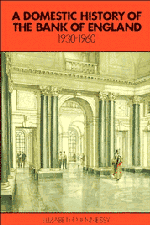Book contents
- Frontmatter
- Contents
- List of illustrations
- Foreword
- Acknowledgements
- Introduction
- 1 The Bank at war
- 2 The Accountant's Department
- 3 Exchange Control, 1939–1957
- 4 The note issue
- 5 The Printing Works
- 6 The Banking Department and the profitability of the Bank
- 7 The Cashier's Department
- 8 The Branches
- 9 Overseas, Economics and Statistics
- 10 The Establishment Department
- 11 The Secretary's Department
- Appendix Governors, Deputy Governors, Directors and Senior Officials, 1930–1960
- Notes
- Index
- Plate section
3 - Exchange Control, 1939–1957
Published online by Cambridge University Press: 05 March 2012
- Frontmatter
- Contents
- List of illustrations
- Foreword
- Acknowledgements
- Introduction
- 1 The Bank at war
- 2 The Accountant's Department
- 3 Exchange Control, 1939–1957
- 4 The note issue
- 5 The Printing Works
- 6 The Banking Department and the profitability of the Bank
- 7 The Cashier's Department
- 8 The Branches
- 9 Overseas, Economics and Statistics
- 10 The Establishment Department
- 11 The Secretary's Department
- Appendix Governors, Deputy Governors, Directors and Senior Officials, 1930–1960
- Notes
- Index
- Plate section
Summary
There was little exchange control in Britain during the First World War, as both the Bank and the Treasury were extremely anxious to preserve the freedom of the exchanges and maintain a normal free gold market in London. Some trade restrictions were imposed and gold exports discouraged but not prohibited; there was no systematic attempt at control until the formation of the London Exchange Committee in November 1915. This was given wide powers, but was in some respects unable, in others unwilling to exercise them, and the cost of the war to the national reserves was certainly greater than it need have been.
After the war, in spite of great efforts to maintain free markets, various forms of control had to be adopted, again with little or no attempt at coordination. In 1926 the Bank set up an Exchange Section for the first time, within the Chief Cashier's Office; valuable experience was provided by C. P. Mahon and L. Lefeaux who had each been seconded at different times to act as Secretary to the London Exchange Committee. The operations of the Section expanded rapidly after the 1931 crisis and Britain's departure from the gold standard, and the following year the Exchange Equalisation Account (EEA) was established in order to ‘check undue fluctuations in the exchange value of sterling’. During the 1930s applications of exchange control became widespread overseas, and included the requisition of foreign exchange earnings, prohibition of exports of capital and various types of compensatory and clearing agreements.
- Type
- Chapter
- Information
- A Domestic History of the Bank of England, 1930–1960 , pp. 83 - 123Publisher: Cambridge University PressPrint publication year: 1992



